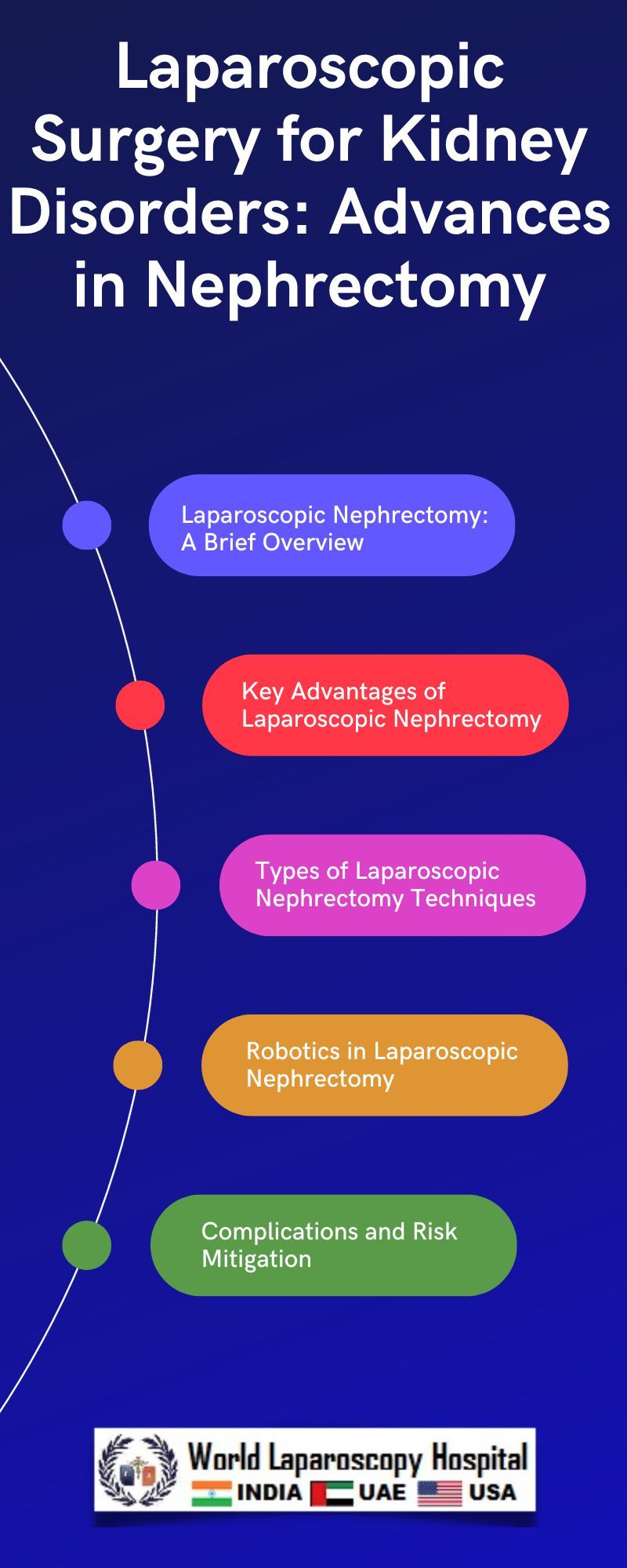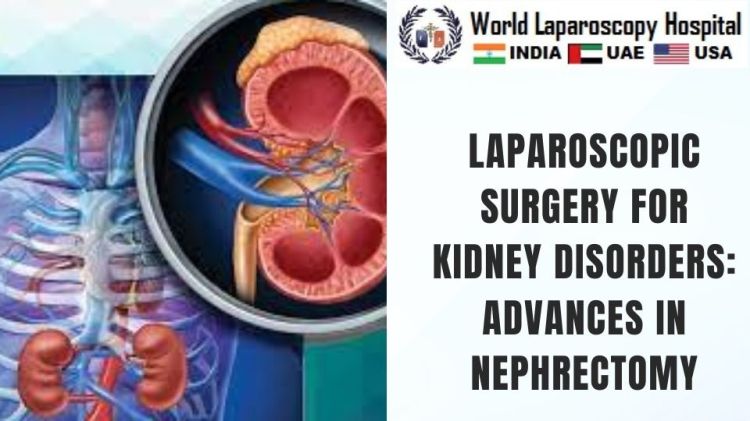Laparoscopic Surgery for Kidney Disorders: Advances in Nephrectom
Introduction:
In the realm of surgical innovation, laparoscopic surgery has emerged as a transformative force, particularly in the domain of nephrectomy for kidney disorders. Over the years, this minimally invasive approach has evolved, ushering in a new era of precision, reduced invasiveness, and enhanced patient outcomes. This article delves into the nuances of laparoscopic nephrectomy, exploring its evolution, techniques, and the profound impact it has had on the landscape of renal surgeries.

The Evolution of Laparoscopic Nephrectomy:
Historical Perspective:
The roots of laparoscopic surgery trace back to the early 20th century, but it wasn't until the late 1980s that it gained prominence in urological procedures. Initially met with skepticism, laparoscopic nephrectomy faced challenges in acceptance due to concerns about its safety and efficacy. However, pioneering surgeons gradually overcame these reservations, demonstrating the feasibility and advantages of this approach.
Milestones and Breakthroughs:
The journey of laparoscopic nephrectomy has been marked by significant milestones. The first laparoscopic donor nephrectomy, a groundbreaking achievement, took place in 1995, showcasing the potential of minimally invasive techniques in kidney surgery. Subsequent advancements, such as hand-assisted laparoscopic nephrectomy and single-port laparoscopy, further refined the procedure, enhancing surgical precision and patient outcomes.
Techniques in Laparoscopic Nephrectomy:
Standard Laparoscopic Nephrectomy:
Patient Positioning and Trocar Placement:Laparoscopic nephrectomy typically begins with the patient in a lateral decubitus position. Small incisions are made to introduce trocars, providing access for the laparoscope and specialized instruments. This strategic trocar placement allows for optimal visualization and maneuverability during the surgery.
Renal Artery and Vein Ligation:One of the critical steps in laparoscopic nephrectomy involves isolating and ligating the renal artery and vein. This delicate maneuver requires precision to minimize blood loss and ensure a safe removal of the affected kidney.
Parenchymal Dissection and Extraction:Careful dissection of the renal parenchyma follows vessel ligation, culminating in the extraction of the kidney. The use of staplers or sutures facilitates the closure of the renal hilum, promoting hemostasis and preventing postoperative complications.
Hand-Assisted Laparoscopic Nephrectomy:
Recognizing the need for tactile feedback, hand-assisted laparoscopic nephrectomy incorporates a hand-port device. This allows the surgeon to insert a hand into the abdominal cavity while maintaining the benefits of laparoscopic visualization. This technique bridges the gap between traditional open surgery and purely laparoscopic approaches.
Single-Port Laparoscopic Nephrectomy:
Continuing the trend toward minimally invasive approaches, single-port laparoscopic nephrectomy consolidates multiple incisions into a single entry point, usually within the umbilicus. This technique aims to further reduce scarring and postoperative discomfort while maintaining the advantages of laparoscopic surgery.
Advantages of Laparoscopic Nephrectomy:
Reduced Postoperative Pain:
Compared to traditional open nephrectomy, laparoscopic procedures are associated with significantly reduced postoperative pain. The smaller incisions and avoidance of large muscle dissection contribute to a more comfortable recovery for patients.
Faster Recovery Time:
The minimally invasive nature of laparoscopic nephrectomy translates to shorter hospital stays and quicker recovery times. Patients often experience a faster return to daily activities and work, minimizing the disruption caused by the surgical intervention.
Improved Cosmesis:
Smaller incisions result in improved cosmetic outcomes, a factor of increasing importance to patients. The diminished scarring enhances the aesthetic aspect of the surgery, addressing not only the functional but also the psychological impact on individuals undergoing nephrectomy.
Comparable Oncological Outcomes:
Numerous studies have affirmed that laparoscopic nephrectomy yields oncological outcomes comparable to open procedures. This has contributed to the broader acceptance of laparoscopy as a viable option for treating kidney cancers.
Challenging Cases and Future Frontiers:
Complex and Radical Nephrectomies:
Laparoscopic nephrectomy has expanded its scope beyond simple nephrectomies, extending to more complex and radical cases. Surgeons are now employing laparoscopic techniques for procedures such as partial nephrectomy, extended lymph node dissection, and even the removal of large renal masses.
Robotics in Nephrectomy:
The integration of robotic-assisted systems has added another dimension to laparoscopic nephrectomy. Robotic platforms offer enhanced dexterity, precision, and three-dimensional visualization, empowering surgeons to navigate intricate anatomical structures with greater ease. As this technology matures, it holds promise for further refining the field of nephrectomy.
Training and Skill Advancement:
The proficiency required for laparoscopic nephrectomy necessitates comprehensive training programs for surgeons. Simulators and virtual reality platforms are increasingly employed to enhance skills in a controlled environment. Continuous education and skill advancement are crucial as the field evolves and embraces emerging technologies.
Patient Selection and Considerations:
Preoperative Assessment:
The success of laparoscopic nephrectomy hinges on meticulous preoperative assessment. Factors such as patient anatomy, comorbidities, and the nature of the kidney disorder play pivotal roles in determining the suitability of this approach. Collaboration between urologists, anesthesiologists, and other specialists is essential for a comprehensive evaluation.
Patient Education and Informed Consent:
Informed consent is a cornerstone of ethical medical practice. Patients must be thoroughly educated about the benefits, risks, and potential complications associated with laparoscopic nephrectomy. Clear communication fosters trust and empowers patients to make informed decisions regarding their treatment.
Challenges and Considerations:
Learning Curve:
Laparoscopic nephrectomy, while offering numerous advantages, poses a learning curve for surgeons transitioning from traditional open techniques. Mastery of laparoscopic skills and adaptation to the nuances of this approach are imperative for ensuring optimal patient outcomes.
Equipment and Cost Considerations:
The adoption of laparoscopic nephrectomy necessitates investment in specialized equipment and infrastructure. While the long-term benefits are evident, healthcare institutions must carefully weigh the initial costs against the enhanced patient outcomes and potential cost savings associated with quicker recovery times.
Patient Factors:
Not all patients are suitable candidates for laparoscopic nephrectomy. Factors such as obesity, extensive scarring from previous surgeries, and complex renal anatomy can pose challenges. Surgeons must carefully evaluate each case to determine the most appropriate surgical approach.
Conclusion:
Laparoscopic nephrectomy stands as a testament to the evolution of surgical techniques in the realm of kidney disorders. From its early days marked by skepticism to the present, where it is considered a standard of care for many cases, laparoscopic nephrectomy has continuously pushed the boundaries of what is achievable in renal surgery.
As technology advances and surgical expertise grows, the future holds even greater promise for refining and expanding the applications of laparoscopic nephrectomy. The delicate balance between innovation, patient considerations, and ethical practice will guide the ongoing journey of this transformative surgical approach, ensuring that it continues to benefit individuals facing
